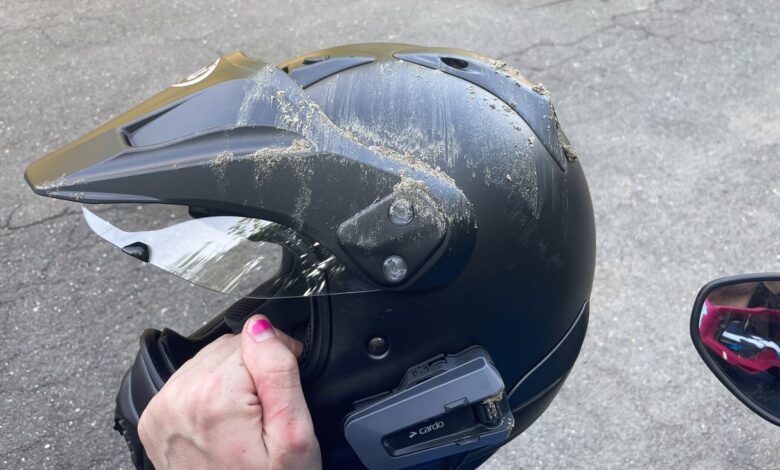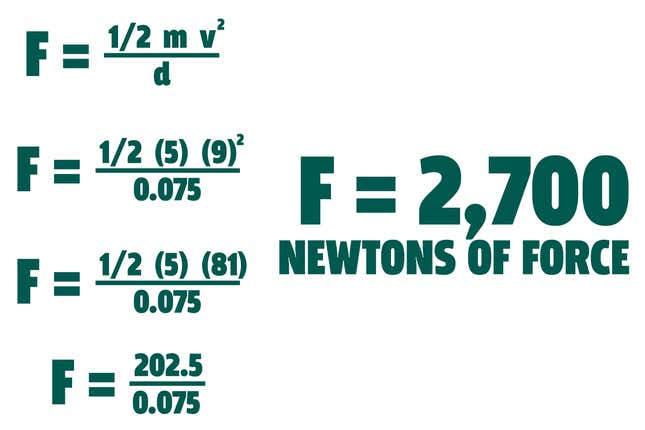I Cannot Overstate The Importance Of A Good Motorcycle Helmet

Two weeks ago, I embarked on my first offroad ride with my BMW F800GS: 100 miles of mixed dirt, gravel, pavement, and mud, stretching from Massachusetts’s southern border to the town of Greenfield. I came back from that trip a better rider — one with experience riding in mud, gravel, and with limited traction. I also came back from that trip concussed.
Slamming your head into pavement at 20 miles per hour is, all things considered, not a particularly bad motorcycle fall — I wasn’t doing highway speeds, I didn’t collide with any track barriers, and I’m still here to write the whole thing up. In fact, it’s such a mild accident that it’s barely even worth writing about at all, except as a reminder: Buy the best helmet you can afford.

For some background, I’ve been riding off road on bicycles for approximately as long as I can remember, if not longer. While I’m new to taking a 500-pound motorcycle on trails, I’m used to navigating through trees on two wheels — line selection, weight balance, standing on the pedals to use your legs as additional suspension, these are all second nature to me.
My issue, apparently, is learning to manage the throttle. When I stared down muddy two-track and decided the solution to my problems was power — keeping momentum up as mud tried to slow me down — things went poorly. The front wheel dug into an unexpectedly deep mud patch and turned sideways, stopping the bike in its tracks and sending me flying off the left side — head- and shoulder-first into pavement.

That fall was minor enough that, after a brief rest, I was able to finish the trail ride (whether or not that was a good idea, having now learned of the horror that is second impact syndrome, is up for debate). My helmet is scratched and scuffed, but I haven’t yet had the time (or mental capacity) to inspect its EPS foam to check if it actually needs replacing. I hope it doesn’t, I don’t want to lose the OHOAT sticker on the back.
But what if I’d left my Arai XD4 at home? What if I’d decided I wanted more fresh air on my face for the trail? Sure, Massachusetts has laws about that sort of thing, but plenty of states don’t — even neighboring Connecticut leaves it up to a rider’s discretion once they turn 18. How would I have fared, hitting my bare skull on pavement?

As it turns out, answering that question is tricky. There are plenty of studies to show how much force it takes to give someone a concussion, all made in attempts to improve the construction of football helmets, but determining how much force is required to actually break a skull is harder. Numbers vary from 73 newtons all the way up to 5,400, which is a range we in the business call “extremely unhelpful.”
Still, out of curiosity, I calculated out the force my head would’ve received without a helmet helping me out. I was travelling about 20 mph when I went down, which converts out to about 9 meters per second in communist (metric) units. The average human head weighs about 5 kg, and we can figure it took about three inches of travel for my head to stop — likely an egregious over-estimate, given that I didn’t dent myself three inches into the pavement, but that’ll hopefully give us a sort of floor to our force numbers. Plug those figures into the formula for determining force from a horizontal impact, and:

Damn! I’m no big-city lawyer, but that sure seems like a lot of force to apply to one’s precious, as-yet-unflayed mind. A force of 2,700 newtons sure is somewhere within that deeply unhelpful range we found earlier, which probably means something. If you’re a brain scientist, please tell me what in the comments below.
The overall theme is clear, though: Even at such slow speeds, such a small impact can apply major trauma to your head. Had I not been wearing a helmet, my recovery period from this concussion would likely have been a lot longer — and that’s if my skull didn’t fracture on the cracked, uneven pavement. If you’re taking your bike out for some late-summer riding, take my advice too. Wear a helmet.




